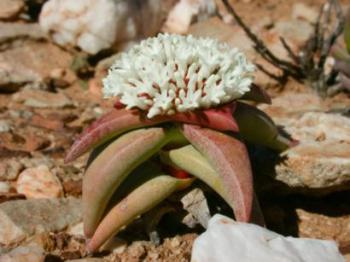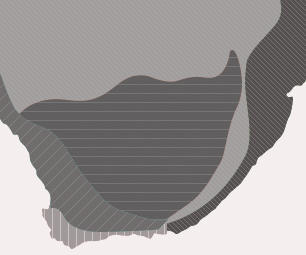Crassula congesta
Crassula congesta N.E.Br.
Family: Crassulaceae
Common names: none found
Introduction
A unique and intriguing dwarf succulent with sweet-smelling flowers well-suited to pot cultivation.

Description
Description
Crassula congesta is a dwarf monocarpic biennial succulent, meaning that it usually lives for only two years in the wild and dies after flowering. It usually grows to about 10 cm in height but sometimes taller in shadier spots and always has only a single stem. The highly succulent leaves taper to an acute point and are usually 25-30 mm long, occasionally channelled above and always convex below.
The inflorescence consists of a capitulum (a head-like inflorescence), densely packed with sweet-smelling tubular creamy white flowers 9-11 mm long and flaring towards the opening. The seeds are fine and dust-like, being released from the dehiscing (spontaneously opening) fruit capsules as soon as they dry, and are wind-dispersed.

There are two recognised subspecies of Crassula congesta : subsp. congesta with leaves that curve upwards; and subsp. laticephala with leaves that curve downwards.

Conservation Status
Status
C. congesta subsp. congesta is not recognized as being threatened; C. congesta subsp. laticephala, however, is considered to be rare.
Distribution and habitat
Distribution description
Both subspecies of Crassula congesta have fairly limited distributions in the Western Cape. C. congesta subsp. congesta is found naturally between Touws River and Laingsburg and C. congesta subsp. laticephala is found between Barrydale and Oudtshoorn. Both are very drought-adapted members of the genus and are usually found growing in full sun in open gravel plains usually associated with white quartzite pebbles.
Derivation of name and historical aspects
History
Crassula is Latin for a small fat female entity. The specific name congesta refers to the very densely congested head of flowers forming the inflorescence.
Ecology
Ecology
Not much is known about the pollination of this species but the pale cream flowers and sweet scent would indicate that it is probably nocturnally pollinated by moths. The light greyish, sometimes dull-red colour of the leaves allow it to camouflage itself well in the white quartzite and gravel in which it grows naturally.
Growing Crassula congesta
Grow
Crassulas are amongst the easiest succulents to cultivate and this species is no exception. However, being monocarpic, it is not likely to live longer than three or four years. Sometimes it will send up a side shoot from the base after flowering and live for another season or two. The secret code for success is very well-drained gritty soils with a low organic content, good ventilation and very bright light which is essential.
Being a dwarf novelty plant, it is recommended to cultivate this species in a pot rather than the open soil. A sunny windowsill should therefore work well, but to keep the plant naturally compact, growing it outdoors in the full sun is recommended. Water sparingly and only when the plant becomes soft to the touch. As they are so drought-adapted their watering requirements are minimal. Overwatering is the easiest way to kill this plant as it will become susceptible to fungal attacks which result in rotting. Feeding is not necessary and will only cause lush growth which will ruin the refined nature of the plant.
Because this plant is single-stemmed and monocarpic, propagation by vegetative means (leaves and stems) is difficult. By far the easiest method of propagation is by seed. Seed would have to be harvested from the plant shortly after it ripens. If not collected promptly the seed will be lost because it is shed as soon as the fruits dry and open.
Crassula congesta is self-fertile, so seed can be obtained even from a single clone. Seed should be sown in autumn. Mix the dust-like seed with a small quantity of fine sand. Fill a pot or tray with the same gritty medium used for the mature plants and spread the seed/sand mixture thinly over the surface. Water immediately, preferably from below by standing the pot in a tray of water every few days. Keep the soil moist like this for the first month or so and always ensure good air movement, i.e. it is definitely preferable to keep the tray outdoors than in. Before long, tiny green plantlets should appear on the soil surface. Start to let the soil dry out between waterings. The use of a damping-off fungicide is advisable, and to aid rapid maturation, a weak liquid fertilizer could be used. Soon the plants will bulk up and if one achieves the ideal growing conditions, one can raise many thousands of plants like this.
References
- Rowley, G. 2003. Crassula, A grower's guide . Cactus & Co. libri.
- Tölken, H.R. 1985. Crassulaceae. Flora of southern Africa 14. Botanical Research Institute, Pretoria.
Credits
Adam Harrower
Kirstenbosch NB
March 2013
Plant Attributes:
Plant Type: Succulent
SA Distribution: Western Cape
Soil type:
Flowering season:
PH:
Flower colour: Cream
Aspect: Full Sun
Gardening skill: Average
Special Features:
Horticultural zones








Rate this article
Article well written and informative
Rate this plant
Is this an interesting plant?
Login to add your Comment
Back to topNot registered yet? Click here to register.